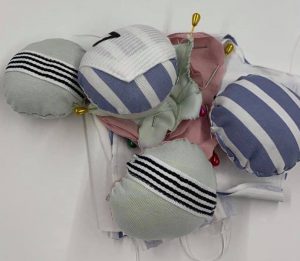Just 10 blocks away from midtown’s ZARA and H&M, Lizi Zhong is trying to change the way students think about their clothing. As the founder of Upcycle, a new club at Hunter, Zhong along with other members are educating students on how to revamp their old clothes instead of buying fast fashion. Contributing to 10% of global carbon emissions, the production of quick textiles is the second-largest industrial polluter.
This new club encourages students to make something new out of their unwanted clothing instead of discarding them. Initial attraction to the club was light but they are using social media to get the word out. Ethical fashion is why Zhong started Upcycle. “A big reason why it’s such a problem is that we don’t value the clothing we buy. We wear them once and then don’t like it anymore so then we throw them out,” said Zhong. At Upcycle, students can learn how to embroider, sew and tailor every Tuesday with the help of club members. “We will be teaching students how to alter and change the design of old shirts,” said Zhong. Members were taught how to create a pin cushion out of old material.
Fast fashion is the creation of inexpensive designs taken from catwalks and high-end collections to meet the demand of trends in a short time frame. Top retailers like ZARA, participate in rapid production that gets distributed in sometimes less than six weeks. Because of this quick turnaround, shoppers are throwing away their seasoned clothes that has amounted to about 11 million tons of waste in the U.S. alone. As fast fashion continues to grow the environmental damages that it causes have increased with it. Each year around 79 billion cubic metres of freshwater are used by the fashion industry.
Molly Baran, a senior majoring in political science, stopped buying fast fashion a while ago. “I haven’t bought from Forever 21 or H&M in so long, can’t even remember honestly,” said Baran. “I live in Brooklyn so I have the best places to secondhand shop like Out of the Closet and Goodwill.” As a college student, Baran enjoys going to these stores because of the low prices. “I can find amazing stuff like cashmere sweaters for 8 bucks, I love finding clothes that still have their tags on for so cheap,” said Baran. Thrifting is expected to double in the next five years to become a $51 billion industry.

Zhong is also a thrifter, she enjoys buying pieces that are unique. “Thrifting is so much fun, its harder to find things but it’s personalized, you almost won’t ever find another piece that is exactly the same,” said Zhong. She knows she can’t thrift everything exactly to her size but that is why upcycling has become such a passion in her life. “I watch videos on Youtube on upcycling, you can take something you don’t use anymore and change it into something you like and will wear again,” said Zhong. A fun way to do this is by embroidering, Zhong is excited to introduce it to her club. “I actually have never embroidered before, so this is something we will be learning together as a club,” said Zhong.
Zhong is one of many young people who have turned to thrift shopping for their appeal. Around 64% of millennials use secondhand stores to get their clothing according to the 2019 ThredUp Resale Report. The report concludes that this trend will grow to nearly 1.5 times the size of fast fashion by 2028. ThredUp is an online thrift store where users can buy and sell their garments. Clubs like Upcycle and websites like ThredUp are trying changing the stigma of buying the latest trends by influencing people to take a better look into their closets.
With a closet full of thrifted and vintage pieces herself, Professor Bridgett Artise has a passion for ethical fashion. Artise teaches sustainability fashion at the Fashion Institute of Technology and is also the owner of her own fashion brand Born Again Vintage. “My whole brand is about keeping clothes in the life cycle and keeping them out of the landfills,” said Artise. An avid thrifter, Artise knows the in and out of second-hand shopping. “What you see at a lot of thrift shops are a tons of H&M and Forever 21, because these clothes are created to last one season so as soon as that season is over they are being thrown away,” said Artise “We see gangs and gangs of clothes that literally just left the racks.” Artise has noticed an increase in price while thrifting. “In the beginning you could really find amazing bargains but now they know what they have and what’s trending so not only have their prices tripled but I would say they increased 50% if not more,” said Artise.
Upcycle’s main goal is to build a community that is conscious about shopping while spreading awareness about fast fashion. “I don’t mind if there aren’t that many members; I just want to gather a group of people who have a common goal and passion to upcycle together, ” said Zhong. Students can find the Upcycle club on the second floor of Thomas Hunter every Tuesday from 5:30 p.m. to 6:00 p.m. Upcycle recently had their final meeting before next semester. Zhong is making efforts to get the word out about Upcycle. “We plan on distributing flyers and bringing food to our future meetings,” said Zhong.

